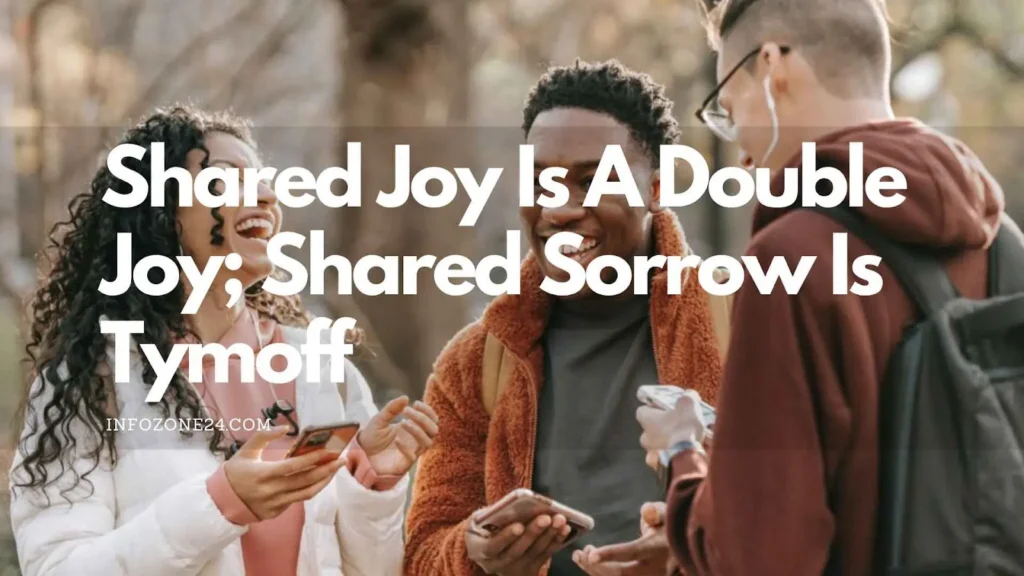The phrase “shared joy is a double joy; shared sorrow is half sorrow” emphasizes how happiness multiplies when shared with others, whereas sorrows lessen when shared. It reflects the idea that sharing positive experiences enhances them while sharing difficulties can lighten the burden.
Imagine sharing a laugh with a friend, feeling that happiness double as it spreads between you. Or sharing a tearful moment, finding solace in knowing you’re not alone in your sorrow. This is the essence of the quote: “Shared joy is a double joy; shared sorrow is half sorrow.”
In this article, we will explore why shared emotions hold such significance, delve into the psychological and scientific insights behind this phenomenon, and discuss practical implications for fostering deeper connections in our relationships and communities. Through these explorations, we will uncover how understanding and embracing shared joy and sorrow can enrich our lives and enhance our well-being.
Understanding Shared Joy
Definition of Shared Joy
Shared joy refers to the emotional experience of happiness or delight intensifying when experienced with others. It involves moments where individuals mutually experience positive emotions, creating a sense of shared happiness that strengthens social bonds and enhances personal well-being.
Psychological Perspective on Shared Joy
According to psychological theories, sharing joy enhances the experience due to several factors. One prominent theory is emotional contagion, where individuals unconsciously mimic the emotions of those around them.
When someone shares their joy with others, this emotional contagion can amplify feelings of happiness through shared smiles, laughter, and positive interactions. Additionally, social comparison theory suggests that sharing joy allows individuals to compare their experiences with others, potentially increasing their satisfaction and happiness.
Neuroscientific Insights into Shared Joy
Neuroscientific research highlights the biological mechanisms that underlie shared joy. Studies using brain imaging techniques have shown that when people experience joy together, areas of the brain associated with reward and pleasure, such as the ventral striatum and nucleus accumbens, are activated.
These brain regions are involved in processing positive emotions and reinforcing social connections, indicating that shared joy is not only a psychological phenomenon but also has a distinct neural basis.
Examples of Shared Joy in Relationships and Experiences
Real-life examples illustrate how shared joy enriches relationships and experiences. For instance, celebrating achievements with friends or family often deepens the emotional bond and creates lasting memories. Sharing joy during communal events like weddings, festivals, or sporting victories brings people together, fostering a sense of unity and collective happiness.
Moreover, in everyday interactions, simple acts of sharing laughter or expressing mutual excitement can strengthen interpersonal connections and contribute to overall well-being.
Impact of Shared Joy
- Workplace Dynamics: Sharing moments of success and happiness in the workplace fosters a positive work environment. It promotes teamwork, boosts employee morale, and enhances productivity.
- Community Engagement: Shared joy strengthens community bonds and encourages civic engagement. It promotes volunteering, collaborative projects, and a sense of collective responsibility.
- Generational Connections: Sharing joyful experiences across generations creates bonds and understanding between younger and older members of families or communities. It passes down traditions and values, fostering intergenerational relationships.
- Creativity and Innovation: Celebrating achievements and positive moments sparks creativity and innovation. It encourages thinking outside the box, problem-solving, and pushing boundaries in various fields.
- Emotional Resilience: Shared joy builds emotional resilience by creating a support network that helps individuals cope with setbacks and challenges. It provides a buffer against stress and adversity.
- Health Benefits: Beyond physical health, shared joy contributes to mental and emotional well-being. It reduces feelings of loneliness and isolation, promoting a sense of belonging and overall happiness.
- Global Impact: In a global context, shared joy can bridge cultural divides and promote understanding between different communities and nations. It highlights common humanity and shared values, fostering peace and cooperation.
Exploring Shared Sorrow
Definition of Shared Sorrow
Shared sorrow occurs when individuals collectively experience feelings of sadness or grief. It involves finding solace and emotional support from others during challenging and distressing periods in life. This shared experience helps individuals cope by knowing they are not alone in their feelings of loss or hardship.
Psychological Impact of Shared Sorrow
Psychologists explain that sharing sorrow can lighten its burden by offering emotional support and validation. Expressing grief with others helps process emotions and lessens feelings of isolation and loneliness. It validates one’s emotional experience and fosters a sense of connection and understanding among those who are grieving together. This mutual sharing of sorrow can promote healing and resilience by acknowledging and addressing feelings in a supportive environment.
Neuroscientific Insights into Shared Sorrow
Neuroscience research indicates that sharing sorrow activates brain regions linked to empathy and emotional regulation. This activation can result in feelings of relief and a deeper sense of connection when individuals grieve together. It shows how our brains respond to shared emotional experiences by enhancing empathy and facilitating emotional processing, which can ultimately aid in coping with grief and finding comfort in collective support.
Cultural and Social Aspects of Shared Sorrow
Different cultures incorporate rituals and practices for communal mourning, highlighting the significance of grieving collectively and supporting those in sorrow. These cultural traditions influence how individuals perceive and manage grief together. Cultural context plays a crucial role in shaping rituals that provide structure and meaning to the grieving process, fostering community support and solidarity during times of loss. Understanding these cultural aspects enhances empathy and respect for diverse ways of coping with sorrow across societies.
Practical Applications of Shared Sorrow
Understanding the benefits of shared sorrow helps individuals seek support from friends, family, or support groups during times of loss. Opening up about grief allows for deeper connections and emotional healing in personal and community settings. Sharing grief fosters mutual understanding and empathy, creating a supportive environment that helps navigate through sorrow and find comfort in collective strength.
Reaching out and connecting with others during times of sorrow is vital for building resilience and promoting healing. It highlights the importance of community support in processing grief and moving forward together.
Benefits of Sharing Sorrow
- Emotional Support: Sharing sorrow lets people express feelings openly and get empathy from others, reducing loneliness and boosting well-being.
- Community and Solidarity: Grieving together builds community bonds and a support network where people comfort and understand each other.
- Research Insights: Studies show that sharing sorrow lowers stress, improves emotional control, and builds resilience over time.
- Cultural Perspectives: Different cultures have rituals for mourning together, showing how communities support each other through grief.
- Personal Growth: Expressing sorrow can help personal growth by helping people process emotions and build resilience.
- Healing through Expression: Sharing grief openly can be therapeutic, helping people release emotions and come to terms with loss.
- Mutual Understanding: Sharing sorrow creates empathy and connection with others who’ve faced similar loss, reducing feelings of isolation.
- Normalization of Grief: It shows that grief is a natural part of life and that it’s okay to feel and talk about these emotions.
- Supportive Networks: It strengthens networks of friends and family who provide comfort and assistance during tough times.
- Shared Coping Strategies: Learning from others’ experiences helps develop effective coping skills for dealing with grief and loss.
- Reduced Psychological Distress: Sharing sorrow can relieve feelings of depression or anxiety by giving emotional relief and validation.
The Science of Shared Emotions
Neurobiological Mechanisms
Shared emotions are supported by neurobiological processes like mirror neurons and empathy. Mirror neurons are brain cells that activate when someone performs an action or observes the same action by others. This mirroring helps individuals internally simulate others’ emotions and actions, which fosters empathy and emotional understanding.
Empathy allows people to resonate with and share others’ emotions. It forms the foundation for shared emotional experiences, enabling individuals to connect deeply with one another through mutual emotional understanding.
Social Contagion
Emotions can spread through social networks via a process known as emotional contagion. When individuals interact closely, emotions like happiness, sadness, or excitement can be transmitted from one person to another. This phenomenon highlights how emotions are not only individual experiences but also communal, influencing group dynamics and collective mood states.
Impact on Well-being
Shared emotions can deeply affect both individuals and groups. Positive emotions such as joy and excitement strengthen bonds and increase feelings of connection. They also boost overall happiness.
Negative emotions like grief or stress can be lessened through communal support. This support fosters emotional resilience and creates a sense of belonging.
In sum, shared emotions contribute to psychological well-being and healthier social interactions by enhancing resilience and promoting a sense of community.
Strengthening Connections Through Shared Experiences
Shared Experiences
Shared experiences go beyond joy and sorrow, encompassing activities like traveling, hobbies, challenges, and milestones. These moments create shared memories and bonds that deepen connections between individuals and within groups.
Impact on Relationships
Shared experiences play a crucial role in building trust and intimacy in relationships. When people share meaningful moments, they develop a sense of camaraderie, understanding, and mutual support. This strengthens emotional bonds, enhances communication, and fosters a sense of belonging and commitment.
The Psychological Benefits of Sharing Emotions
Therapeutic Effects
Sharing emotions can lead to emotional release and catharsis by allowing individuals to express their feelings openly. This process can alleviate emotional tension, reduce stress levels, and promote a sense of relief and clarity.
Enhanced Empathy
Sharing emotions fosters empathy and understanding among individuals by allowing them to connect on a deeper emotional level. When people share their emotional experiences, it enhances their ability to recognize and relate to the feelings of others, promoting compassionate interactions and supportive relationships.
Psychological Resilience
Sharing emotions contributes to psychological resilience and well-being by providing a support network that helps individuals cope with challenges. It encourages adaptive coping strategies, builds confidence in facing adversity, and strengthens emotional stability over time.
The Power of Connection
Human Connection
Human connection through shared emotions creates profound impacts, fostering empathy, understanding, and a sense of belonging. It strengthens relationships and enhances overall well-being by validating emotions and promoting mutual support.
Social and Cultural Significance
Connection through shared experiences holds broader implications in society, fostering cohesion, unity, and cultural identity. It promotes social bonds, collective resilience, and shared values that shape communities and societal norms.
Personal Growth
Embracing shared emotions can lead to personal growth and fulfillment by encouraging self-awareness, empathy development, and emotional resilience. It facilitates learning from others, broadening perspectives, and nurturing a deeper understanding of oneself and others.
Cultural and Historical Perspectives
Cross-Cultural Comparisons
Attitudes toward sharing joy and sorrow vary significantly across different cultures. Some cultures may emphasize communal celebrations and collective expressions of joy, viewing them as essential for social cohesion and unity. In contrast, others may approach sorrow with rituals that promote communal grieving and mutual support, reflecting cultural values and traditions that shape emotional experiences.
Historical Context
Throughout history, various examples and traditions highlight the significance of communal emotions. Ancient civilizations often practiced collective rituals during times of joy or sorrow, reinforcing social bonds and cultural identity. Historical events, such as ceremonies or festivals, also underscored the importance of shared emotions in shaping community resilience and cultural continuity.
Practical Applications in Modern Life
Personal Relationships
Strengthen joy in personal relationships by actively participating in celebrations and acknowledging achievements. Show support during difficult times by listening empathetically and offering practical assistance. Sharing both positive and challenging emotions builds trust and deepens connections.
Social Media and Technology
Social media platforms provide avenues for expressing emotions instantly and connecting with a wide audience. They can amplify joy through shared celebrations and support during sorrowful moments. However, ethical considerations arise concerning privacy, authenticity, and the potential impact of public sharing on personal well-being.
Ethical Considerations
When sharing emotions online, it’s crucial to consider ethical dilemmas such as respecting others’ privacy and avoiding the exploitation of personal experiences for attention. Authenticity and sensitivity in communication help maintain trust and integrity in digital interactions. Balancing emotional expression with ethical awareness ensures meaningful and respectful engagement in online and public spaces.
Conclusion
Personally, the quote “Shared Joy Is A Double Joy; Shared Sorrow Is Tymoff” resonates deeply. Embracing shared emotions offers a pathway to deeper connections and emotional well-being. By celebrating joys together and supporting one another through sorrows, we contribute to a more compassionate and resilient society.
Understanding the science and cultural nuances of shared emotions enriches our ability to connect authentically and empathetically in a diverse and interconnected world.



